
Sketchnotes for Beginners: My 1st Time & Tips for Being Better Than Me
I’ve not always been in events, but since I’ve been working at Tito, one of the notions that thrills me about the industry is the idea of creating a spectacle.
The attention to detail that conference organisers put into their events inspires me. A lot of the organisers I’ve met through my work at Tito have proven to me that there is a definite importance to good design at events.
Not only do beautiful visuals foster a sense of awe in attendees while events are ongoing, they’re one of the most memorable aspects of the event well after it’s come to an end. In a practical sense, that inspiration helped me put together this intro to sketchnotes for beginners.
How and why I got started
A few weeks before attending a recent conference in Munich, I’d found Andy’s sketchnotes while working an interview, and I thought it was such a wonderfully creative way to share what you learn at events while celebrating the visuals that their production teams and presenters work so hard on.
I thought taking sketchnotes might be a bit intimidating to get started, but I was pleasantly surprised when I was able to pull it off. Of course I made some mistakes, as any first-timer would, but thankfully that means I can share them with you so you get a head start if you want to try taking sketchnotes for yourself.
What I bought
I went to Flying Tiger, which is my go-to for quick access to affordable stationery. For those of you unfamiliar with the brand (since they only have 16 shops in the USA at time of writing), it’s kind of a toy-come-bric-a-brac-come-kitchenware-come-stationery-come-everything type of place.
Annie likened it most closely to Target when I spoke with her about it, if that helps. For me at least, shopping in a place like that can be overwhelming when it comes to the amount of choice you have. Since I was hunting down drawing materials, I could have chosen anything from a calligraphy set to a 12-pack of wax crayons.
But, I bought the following:
A black notebook which,
- Looks chicer than its price tag,
- Which I thought important because I preferred to give off an air of professionalism more than pre-school art teacher.
- Has a bookmark for quick access to a clean page, and
- Has blank paper to compliment any layout you choose.
A set of 12, multicoloured, fine-tip marker pens.
- These are pretty much the closest I can find online.
- They are the most compact way to have as many colours available as you want.
- They don’t bleed as badly as regular felt tips with a broader top.
A set of 4, black, fine-tip market pens.
- Ditto everything above, minus colour.
What you could buy instead
A 0.5 mm and a 1mm black fineliner and a couple of colours for highlight
Hat-tip to our junior designer, Dearbhla, for this one. She recommends Staedtler, with two notes of caution:
- They can be a little bit expensive, so any fineliners are actually fine.
- Be careful about pen bleeding on regular refill pads and notebooks.
My own teeny-tiny word of discouragement when it comes to sketchnoting equipment is that I find Sharpies melt through notebook paper too easily to make them worth bringing in your sketchnote supplies. Sorry, America.
Any old notebook
Unless you’re very particular about paper quality, when you’re staring out with sketchnotes it’s okay to go with anything that has blank paper. My only caveat about notebook selection is that you should buy something hardback that’s not going to crumple when you’re travelling, thus ruining all your good work.
If you’re feeling particularly bougie though, I’ve seen this Maruman Notebook recommended several times, as well as the good ol’ Moleskin.
The Downsides
Sketchnoting is hard
When I went into this experiment, I thought that sketchnoting was going to be adult, absent-minded doodling. Little did I realise I was reflecting a common arrogance.
People who can draw really love saying, ” I don’t know! I just do it!” when people ask them for advice. I’ll be the first to tell you that I think it’s rather a bit more complicated than that.

Deciding what symbols and icons to draw is hard. Choosing a layout you can follow is hard. Choosing which words go with what you’re drawing is hard. Keeping your handwriting legible at speed is hard. Sketchnoting is hard, but (as we’ll talk about later) hard work pays off, most of the time.
Solution: If you want in-depth tutorials on how to start drawing, this is probably the wrong blog. But, what has helped me in the past is going to a facilitated art class or joining a group of other people who regularly draw and provide feedback together.
The benefits of a class are that you can ask the tutor questions, get tailored critiques, and (unlike a lot of other classes) bring home something that you can keep as a reminder of what you’ve learned, that expresses your creativity, and that looks nice.
And, best of all, for the second option, it’s easy to find a meetup where people share feedback and tips they’ve learned almost anywhere you’re based; you don’t need to spend heaps of money on professional qualifications to improve your drawing.
You have to carry a lot of stuff around to take sketchnotes
I should qualify that “a lot of stuff” in the context of a conference environment is anything larger than an iPhone.
Whatever your materials of choice, they’re going to add bulk; especially difficult when you find yourself sprinting — without trying to make it obvious you’re sprinting — throughout the conference centre.
Solution: Though it might seem obvious, the humble backpack is what I favour over other ways of carting personal belongings around at events. Wirecutter has a good list of business backpacks if you’re in the market to make an investment.
Plenty of people prefer shoulder bags, but as someone who’s had repetitive strain injury in their right arm exacerbated by them, I’ve fallen out of love.
You can over-focus on design
On top of general distraction, there’s a liability for us to never finish something we draw. Well, there’s at least a liability for us to think something we make is never finished. I’m guilty of being precious with things I make, given that writing is the major part of my day job. From experience, please ignore that little voice telling you that you can do better if you just tweak this, edit that, delete those, etc.
You have a limited amount of time to capture a main talking point before the speaker goes on to the next one. And, no matter how clear they are on their slides, you won’t know when that’s coming or what it will be. It’s better to have the outline of a speaker with rather than a detailed half of their face that ends up looking like the Moon from Bear in the Big Blue House, signifying nothing.
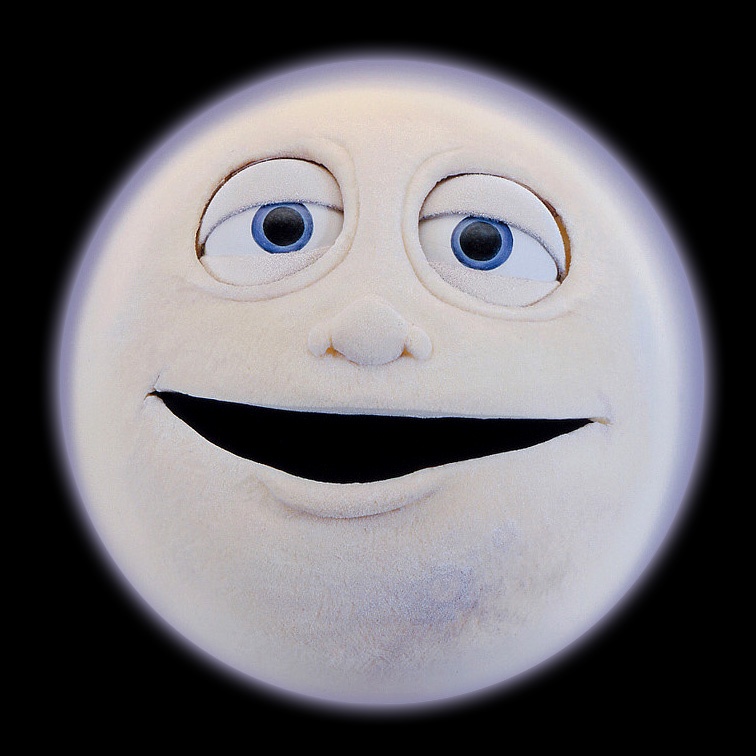
Solution: You can cheat.
Feel free to tidy up the illustrations you’ve made once the session you’re documenting comes to an end. No one will know except you (and me, possibly). Plus, colouring is a sure-fire way to decompress after a day of sessions when you’re back in your hotel room. And it’s certainly much better than trying to decipher the millennial politics of Love Island auf deutsch, from experience.
You’re liable to ignore the speaker
I can’t remember anything about the opening keynote from the conference I was taking sketchnotes at, except that the people invited to talk about their code for retailers said their programming was “totally rad” and that they were wearing lederhosen.
I attribute this partially to shoe sales being far on the outskirts of my professional interests, and partially to the fact that I was trying to draw the wrinkles in the interviewer’s shirt at the time. See below:
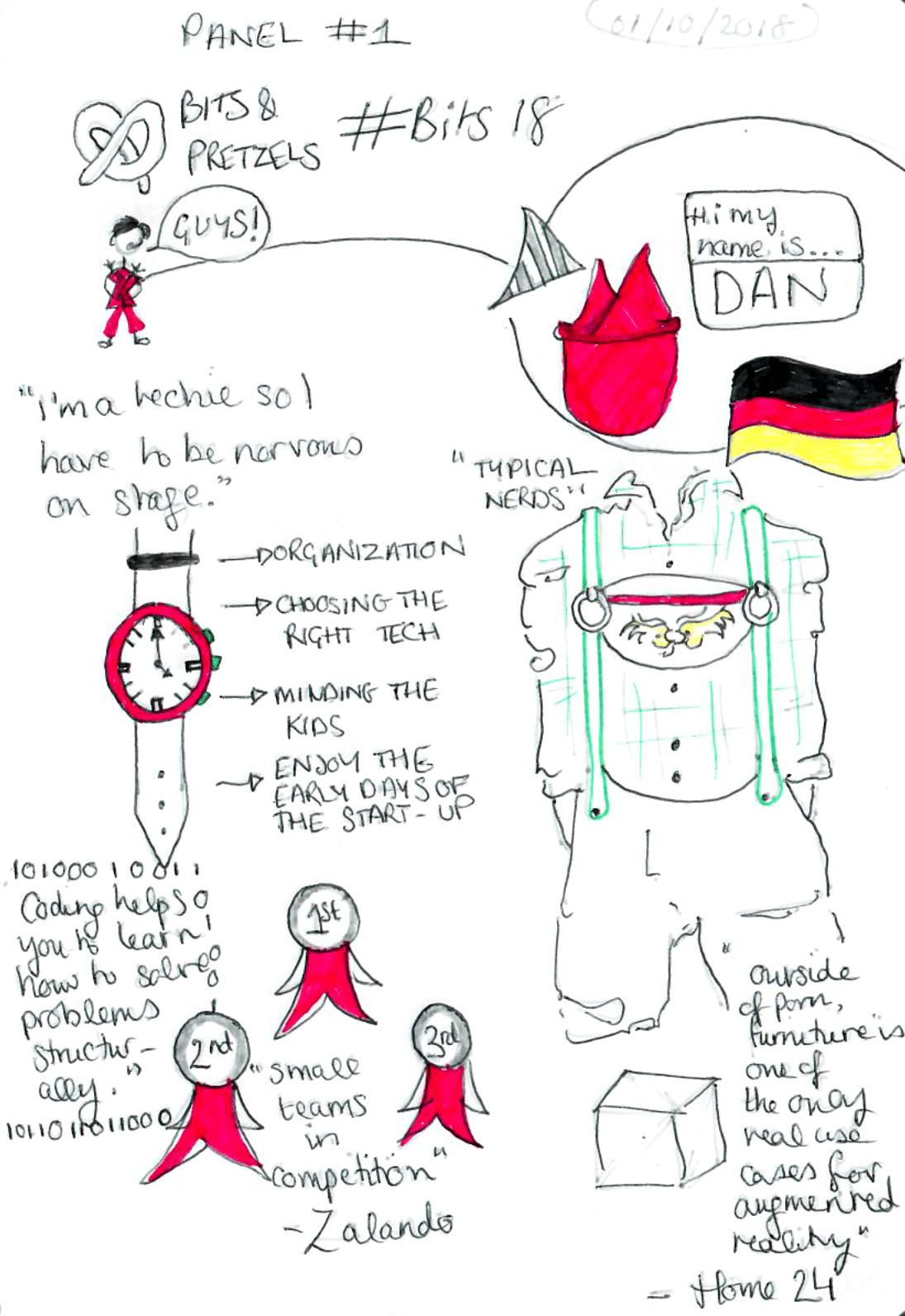
It’s easy to get lost or lose concentration when you’re in an audience. Adding a deliberate distraction for yourself will, unsurprisingly, make you more liable to zone out.
Solution: If you’re only using sketchnotes to share what you learned from the talk, an alternative option is to record the talk, or download the professional recordings and draw what you want at a later time.
Again, this can feel a little like cheating, but think of it this way: people do the same when they’re revising and studying all the time and it helps them to retain information while making that information easier to absorb all at once, so really it’s a win-win.
The efficacy of sketchnotes depends on what kind of learner you are
I always thought that people either learned a) by physically doing what they’re supposed to be learning or b) by listening to someone explaining how to do it. Later, I humbly learned that people learn in no fewer than seven different ways. The seven types of learning I now know about are; visual, aural, verbal, physical, logical, social, and solitary.
A piece of paper with a nice picture on it hardly satisfies all of those, meaning that some people won’t benefit from taking sketchnotes or from examining others’.
There are quizzes online that can help you estimate what balance of learning types best suit your preferences. A note here that this one is visually quite crap, contains 70 questions and requires you to fill in a form to get your answers, so don’t do it.
This one by Chegg is short, and possibly loses out on the accuracy front as a result, but the interface is much nicer. I’m suggesting this one because the other three I looked up were a) a matrix that skewed all over the place and was virtually un-usable, b) clickbait with pop up ads that tried to make me buy that coat I saw on Facebook that one time or, c) a 404 error.
I learned that I’m a visual learner, probably obvious because I’m writing a blog post about sketchnotes, but I was interested to learn that 20.6% of the population are also estimated to fall into this category:
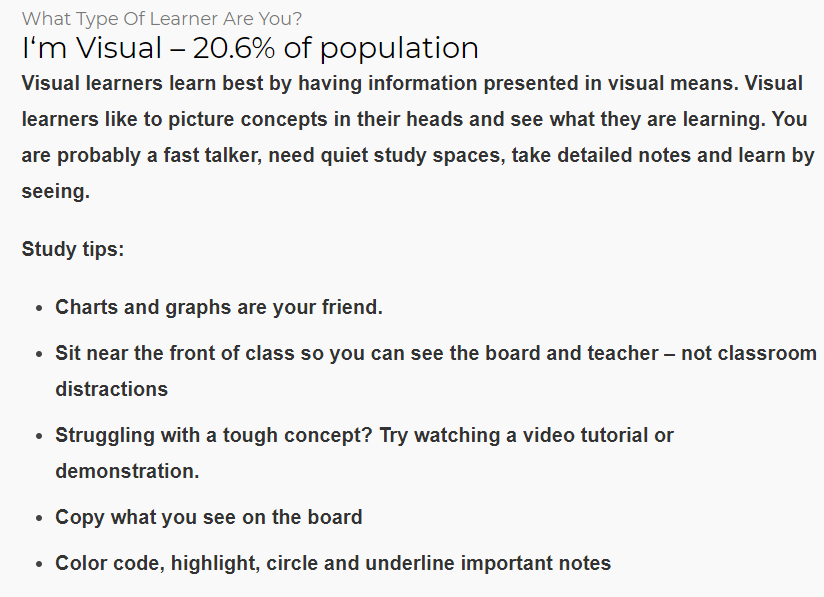
Solution: Thankfully, there are lots of different ways to take in and review what we learn at conferences. Graciously, American River College in California has put together an open-access list of different learning methodologies that are most effective for people who learn in different kinds of ways.
Bonus fact! People in North Dakota are really interested in sketchnotes:
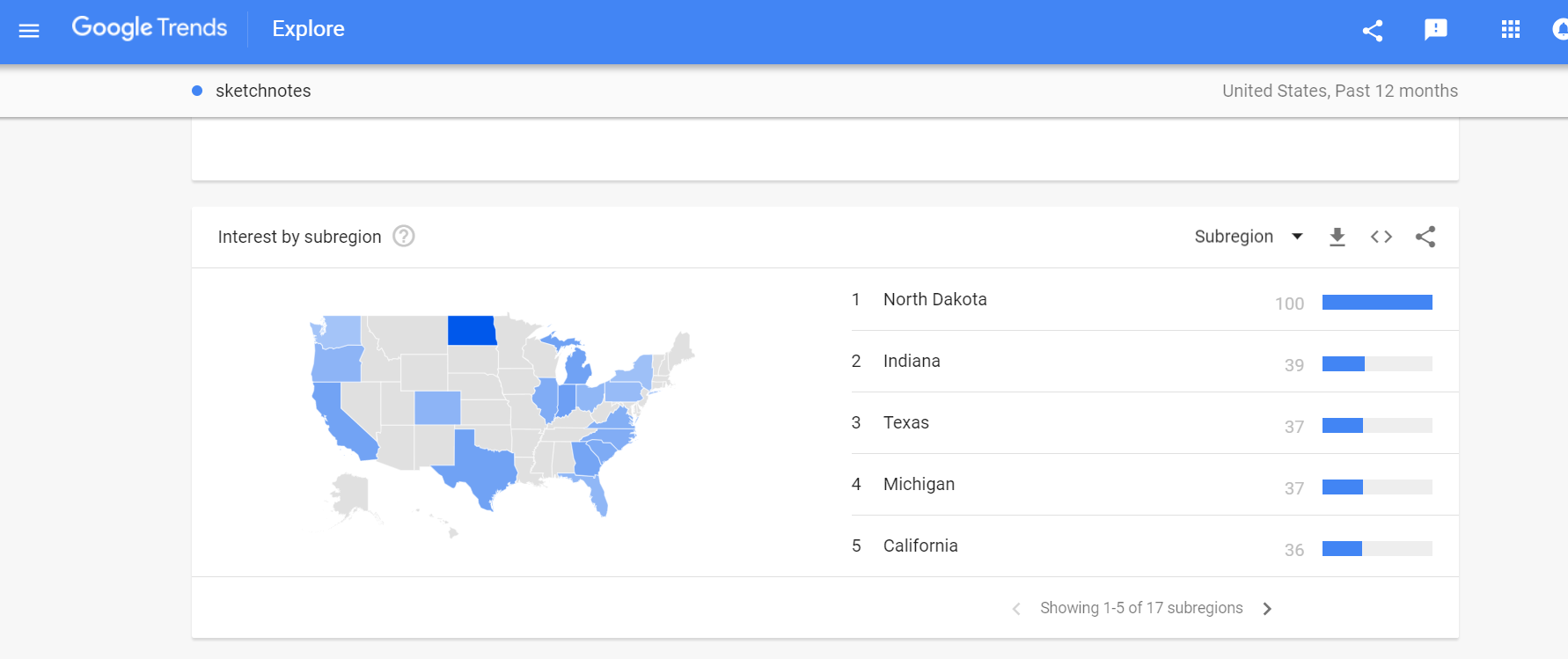
The Upsides
The sketchnotes encapsulate experiences you might otherwise forget
For me, the image that resonated most with me from the conference when I was looking back over my notes was a dog costume (illustrated below).
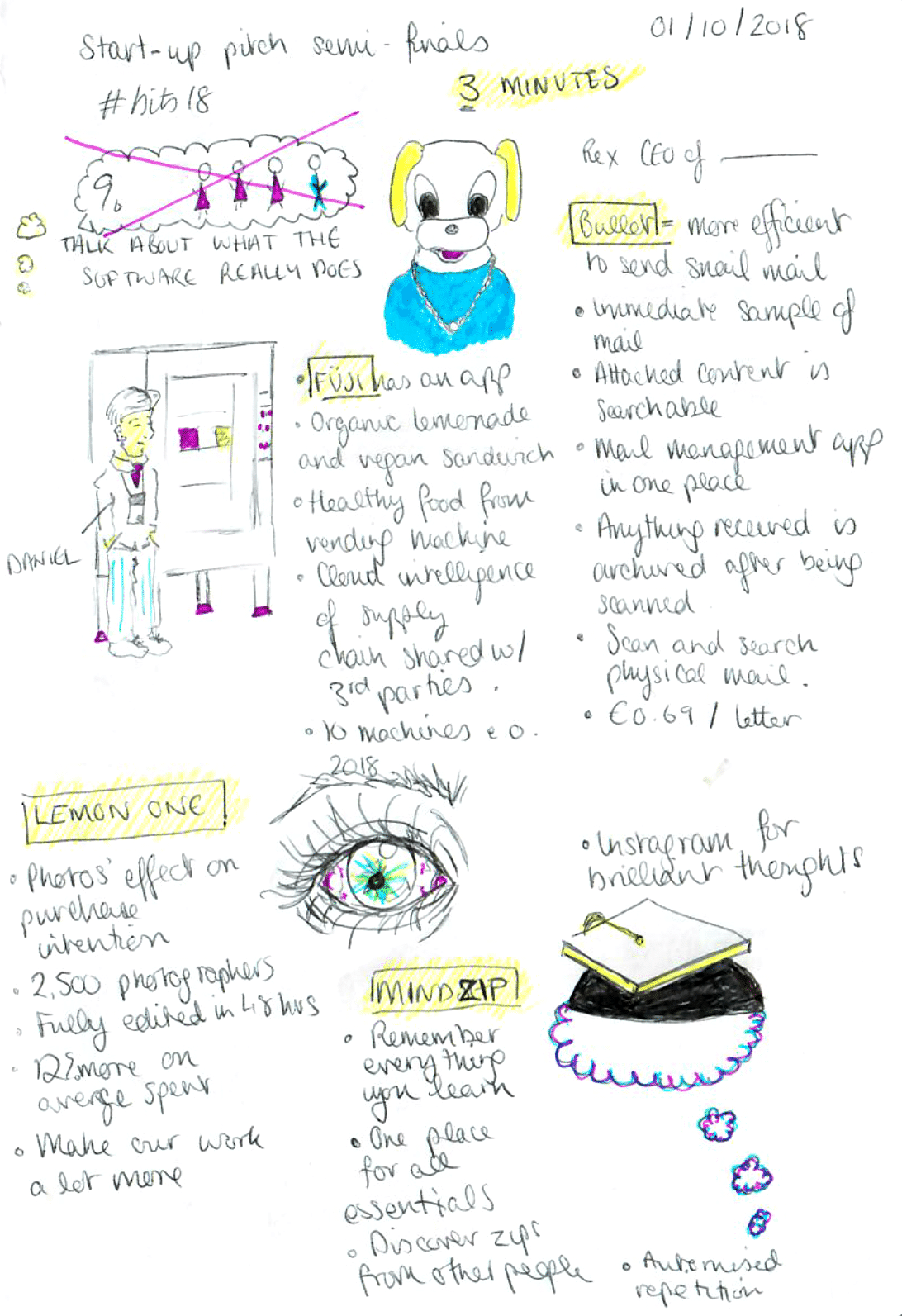
What’s nice about this is that sketchnotes helped me to remember that there was a sense of whimsy at the event. The costume in question was one of the presentation gimicks a company presenting at the start-up pitch semi-finals took upon themselves to use.
On its own, the idea of a dog’s head in a bling chain can come off a little macabre, but the shock value of it probably kept the company top-of-mind for the judges as well as the audience. And knowing that silly things like that are welcome there, it’s certainly something that makes the brand of the conference more appealing, separating it from the stuffy corporate overtones it could have fallen victim to.
You feel extremely talented and smart
During my last ever art exam in school, the guy sitting beside me had so fully given up (he had a basketball scholarship to the college he wanted to go to, don’t worry) that he spent the whole three hours drawing a 3-inch diameter circle and repeatedly colouring it in with an orange crayon.
Shortly after we left the exam hall he could be overheard telling friends it went “really, really well.”
When you’re ready to come up from your head desk, you’ll know that it’s nice to be proud of things that you accomplish, even if other people don’t appreciate what you personally put into them.
Ditto for sketchnotes. Sure, your microphone might look more like a corn cob, but if it signifies what you want it to, and helps you remember whatever problem the microphone holder helped you with, then it’s fine.
Sketchnotes are very shareable
If you’ve graduated from corn-cob-looking microphones (and, oftentimes, even if you haven’t) people want to share pretty things to impress their audiences.
People consume so much information on the internet that, when they actually learn something, they want to share that gratification with their friends and followers.
It’s a good way to start conversations
If you ever stopped paying attention in school and started doodling in the margins, you’ll be familiar with the momentary terror of having to answer, “Oh cool!! What’re you drawing?”
As a grown up, it mightn’t be less awkward to answer, but it’s certainly more rewarding.
I find going to conferences in cities where English isn’t the first language and where I don’t know anyone scary (who doesn’t?) so I was extremely glad that people were comfortable enough to ask questions and strike up conversations about the talks when they saw me drawing. The couple of compliments I got also made me feel a lot more comfortable with what I was doing.
What next?
Scan your work the second you get anywhere near a scanner. I mean it. If, like me, you used a black notebook, even if you bought it specially, you will use it for other things, finish it, throw it out or just lose it.
In the grander scheme of things, sketchnoting taught me how to better pay attention to what was going on at the conference, by making me pay less attention. What I mean is that I usually spend the duration of talks at conferences taking notes on my laptop which inevitably leads to me checking emails or otherwise wandering around the internet.
Taking sketchnotes is a slower-burner in that you take more time to take note of the same amount of information, and if you get distracted you simply don’t get time to take a record of what you want to remember.
From now on, I’ll certainly be taking sketchnotes at events like the one these are from which had a broad focus (start-ups), but for more technical conferences (like SEO events, for instance) I’ll probably stick to the written word, though I will still be reaching for a notebook as a result of this experiment.
If you’d like to try your hand at sketchnoting and want some inspiration as to layout and techniques, I recommend the following:
- The Think Company on Flickr,
- Verbal to Visual,
- Andy McNally’s sketcnotes from Layers,
- Makayla Lewis on Flickr,
- The sketchnotes from previous editions of Clarity Conf.
And, if you want to keep up to speed with blog posts like this, you can subscribe for occasional email updates here: